Financial Reporting Analysis of Gazal Corporation Limited: A Report
VerifiedAdded on 2021/05/31
|6
|1849
|27
Report
AI Summary
This report provides a comprehensive analysis of the financial reporting practices of Gazal Corporation Limited (GCL), an Australian clothing brand. The analysis covers various aspects of financial accounting, including provisions, fair value measurement of financial assets, and revenue recognition. It examines how GCL accounts for leases under AASB 16, classifies and values intangible assets, and determines the discount rates used for valuation purposes. The report highlights key considerations for financial reporting, such as the treatment of contingent liabilities, the application of the effective interest method, and the valuation of inventory based on net realizable value. Furthermore, the report discusses the methods employed to value intangible assets, including trademarks and patents, and the importance of differentiating revenue streams for accurate financial assessment. The analysis draws upon GCL's annual report and relevant accounting standards and literature.
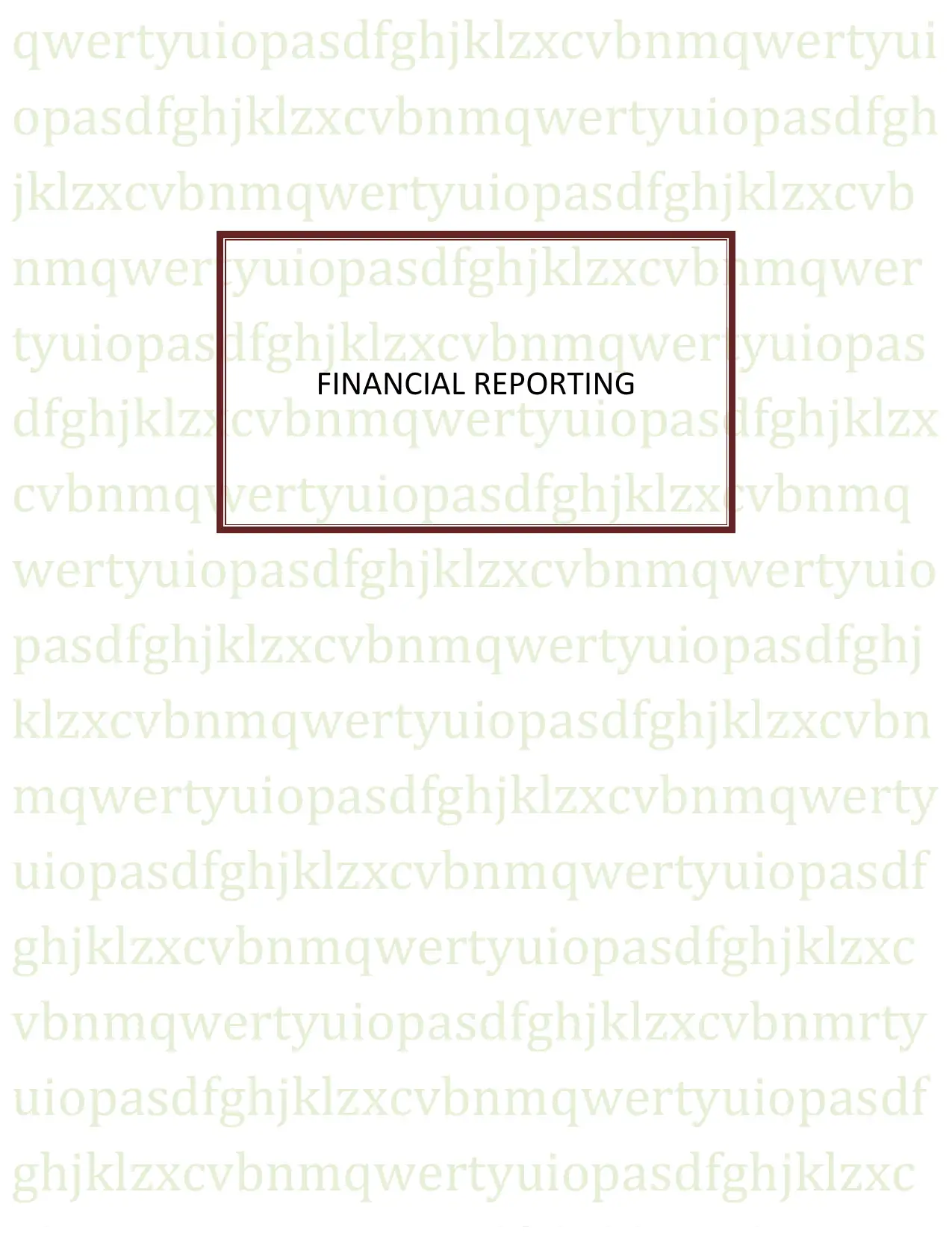
qwertyuiopasdfghjklzxcvbnmqwertyui
opasdfghjklzxcvbnmqwertyuiopasdfgh
jklzxcvbnmqwertyuiopasdfghjklzxcvb
nmqwertyuiopasdfghjklzxcvbnmqwer
tyuiopasdfghjklzxcvbnmqwertyuiopas
dfghjklzxcvbnmqwertyuiopasdfghjklzx
cvbnmqwertyuiopasdfghjklzxcvbnmq
wertyuiopasdfghjklzxcvbnmqwertyuio
pasdfghjklzxcvbnmqwertyuiopasdfghj
klzxcvbnmqwertyuiopasdfghjklzxcvbn
mqwertyuiopasdfghjklzxcvbnmqwerty
uiopasdfghjklzxcvbnmqwertyuiopasdf
ghjklzxcvbnmqwertyuiopasdfghjklzxc
vbnmqwertyuiopasdfghjklzxcvbnmrty
uiopasdfghjklzxcvbnmqwertyuiopasdf
ghjklzxcvbnmqwertyuiopasdfghjklzxc
FINANCIAL REPORTING
opasdfghjklzxcvbnmqwertyuiopasdfgh
jklzxcvbnmqwertyuiopasdfghjklzxcvb
nmqwertyuiopasdfghjklzxcvbnmqwer
tyuiopasdfghjklzxcvbnmqwertyuiopas
dfghjklzxcvbnmqwertyuiopasdfghjklzx
cvbnmqwertyuiopasdfghjklzxcvbnmq
wertyuiopasdfghjklzxcvbnmqwertyuio
pasdfghjklzxcvbnmqwertyuiopasdfghj
klzxcvbnmqwertyuiopasdfghjklzxcvbn
mqwertyuiopasdfghjklzxcvbnmqwerty
uiopasdfghjklzxcvbnmqwertyuiopasdf
ghjklzxcvbnmqwertyuiopasdfghjklzxc
vbnmqwertyuiopasdfghjklzxcvbnmrty
uiopasdfghjklzxcvbnmqwertyuiopasdf
ghjklzxcvbnmqwertyuiopasdfghjklzxc
FINANCIAL REPORTING
Secure Best Marks with AI Grader
Need help grading? Try our AI Grader for instant feedback on your assignments.
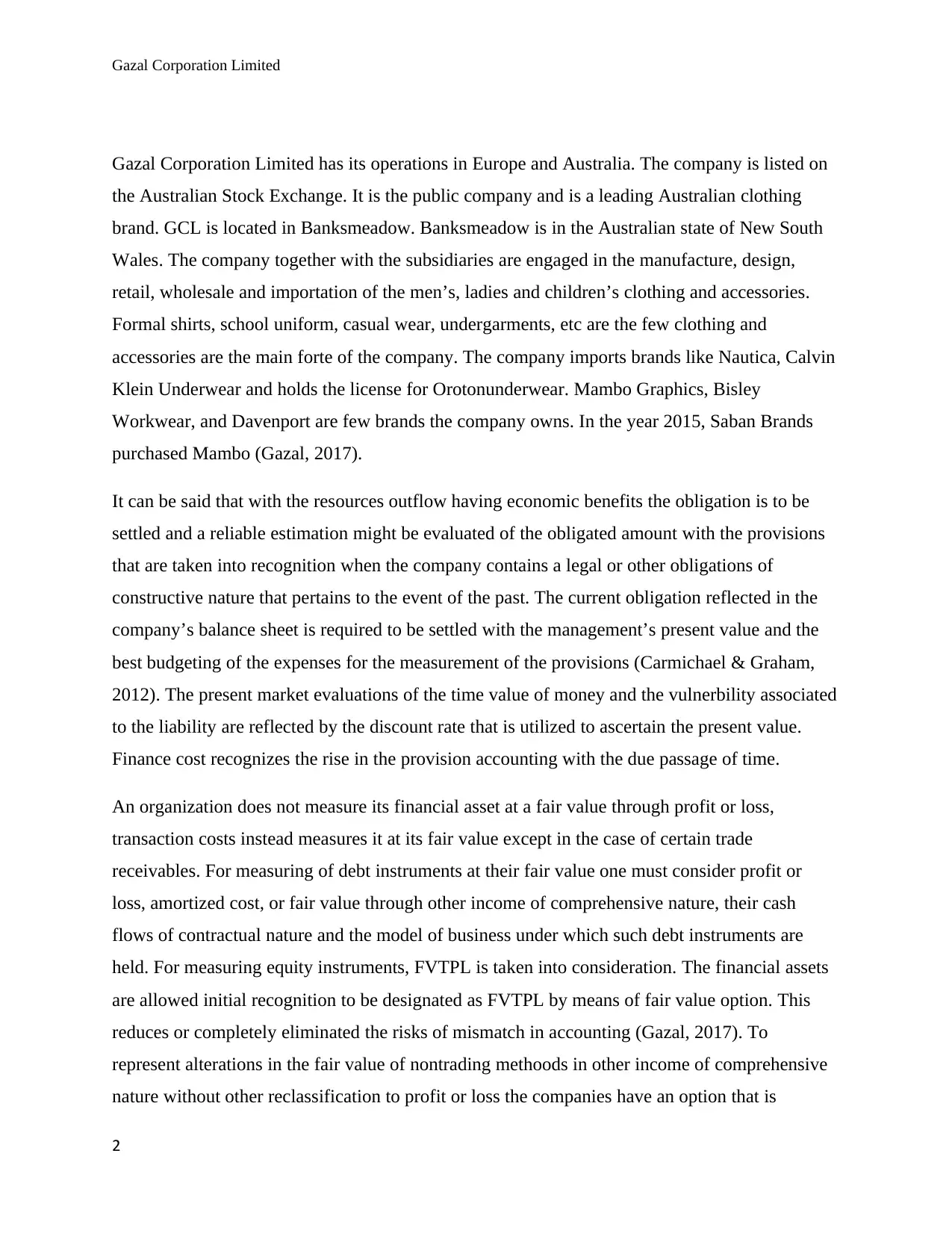
Gazal Corporation Limited
Gazal Corporation Limited has its operations in Europe and Australia. The company is listed on
the Australian Stock Exchange. It is the public company and is a leading Australian clothing
brand. GCL is located in Banksmeadow. Banksmeadow is in the Australian state of New South
Wales. The company together with the subsidiaries are engaged in the manufacture, design,
retail, wholesale and importation of the men’s, ladies and children’s clothing and accessories.
Formal shirts, school uniform, casual wear, undergarments, etc are the few clothing and
accessories are the main forte of the company. The company imports brands like Nautica, Calvin
Klein Underwear and holds the license for Orotonunderwear. Mambo Graphics, Bisley
Workwear, and Davenport are few brands the company owns. In the year 2015, Saban Brands
purchased Mambo (Gazal, 2017).
It can be said that with the resources outflow having economic benefits the obligation is to be
settled and a reliable estimation might be evaluated of the obligated amount with the provisions
that are taken into recognition when the company contains a legal or other obligations of
constructive nature that pertains to the event of the past. The current obligation reflected in the
company’s balance sheet is required to be settled with the management’s present value and the
best budgeting of the expenses for the measurement of the provisions (Carmichael & Graham,
2012). The present market evaluations of the time value of money and the vulnerbility associated
to the liability are reflected by the discount rate that is utilized to ascertain the present value.
Finance cost recognizes the rise in the provision accounting with the due passage of time.
An organization does not measure its financial asset at a fair value through profit or loss,
transaction costs instead measures it at its fair value except in the case of certain trade
receivables. For measuring of debt instruments at their fair value one must consider profit or
loss, amortized cost, or fair value through other income of comprehensive nature, their cash
flows of contractual nature and the model of business under which such debt instruments are
held. For measuring equity instruments, FVTPL is taken into consideration. The financial assets
are allowed initial recognition to be designated as FVTPL by means of fair value option. This
reduces or completely eliminated the risks of mismatch in accounting (Gazal, 2017). To
represent alterations in the fair value of nontrading methoods in other income of comprehensive
nature without other reclassification to profit or loss the companies have an option that is
2
Gazal Corporation Limited has its operations in Europe and Australia. The company is listed on
the Australian Stock Exchange. It is the public company and is a leading Australian clothing
brand. GCL is located in Banksmeadow. Banksmeadow is in the Australian state of New South
Wales. The company together with the subsidiaries are engaged in the manufacture, design,
retail, wholesale and importation of the men’s, ladies and children’s clothing and accessories.
Formal shirts, school uniform, casual wear, undergarments, etc are the few clothing and
accessories are the main forte of the company. The company imports brands like Nautica, Calvin
Klein Underwear and holds the license for Orotonunderwear. Mambo Graphics, Bisley
Workwear, and Davenport are few brands the company owns. In the year 2015, Saban Brands
purchased Mambo (Gazal, 2017).
It can be said that with the resources outflow having economic benefits the obligation is to be
settled and a reliable estimation might be evaluated of the obligated amount with the provisions
that are taken into recognition when the company contains a legal or other obligations of
constructive nature that pertains to the event of the past. The current obligation reflected in the
company’s balance sheet is required to be settled with the management’s present value and the
best budgeting of the expenses for the measurement of the provisions (Carmichael & Graham,
2012). The present market evaluations of the time value of money and the vulnerbility associated
to the liability are reflected by the discount rate that is utilized to ascertain the present value.
Finance cost recognizes the rise in the provision accounting with the due passage of time.
An organization does not measure its financial asset at a fair value through profit or loss,
transaction costs instead measures it at its fair value except in the case of certain trade
receivables. For measuring of debt instruments at their fair value one must consider profit or
loss, amortized cost, or fair value through other income of comprehensive nature, their cash
flows of contractual nature and the model of business under which such debt instruments are
held. For measuring equity instruments, FVTPL is taken into consideration. The financial assets
are allowed initial recognition to be designated as FVTPL by means of fair value option. This
reduces or completely eliminated the risks of mismatch in accounting (Gazal, 2017). To
represent alterations in the fair value of nontrading methoods in other income of comprehensive
nature without other reclassification to profit or loss the companies have an option that is
2
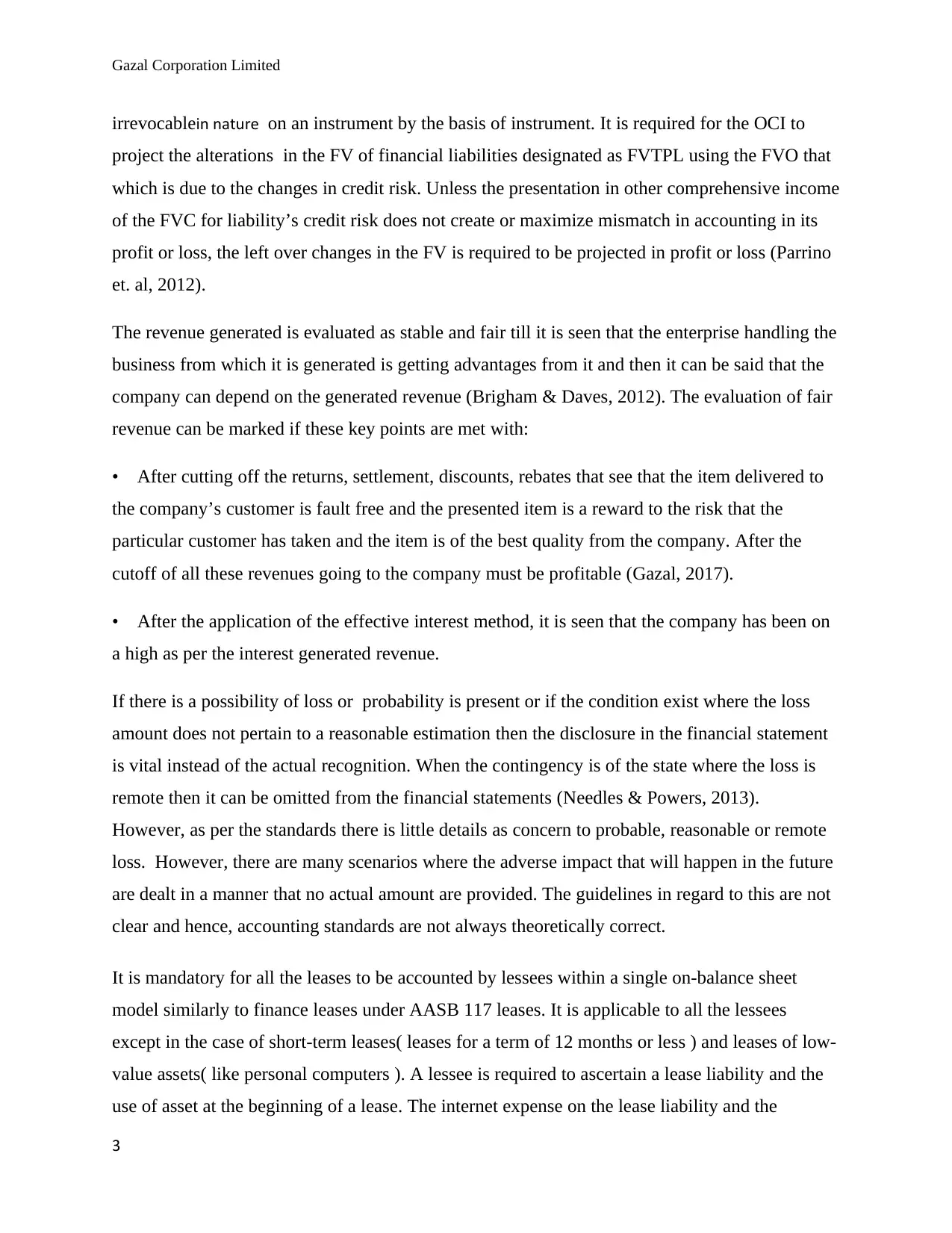
Gazal Corporation Limited
irrevocablein nature on an instrument by the basis of instrument. It is required for the OCI to
project the alterations in the FV of financial liabilities designated as FVTPL using the FVO that
which is due to the changes in credit risk. Unless the presentation in other comprehensive income
of the FVC for liability’s credit risk does not create or maximize mismatch in accounting in its
profit or loss, the left over changes in the FV is required to be projected in profit or loss (Parrino
et. al, 2012).
The revenue generated is evaluated as stable and fair till it is seen that the enterprise handling the
business from which it is generated is getting advantages from it and then it can be said that the
company can depend on the generated revenue (Brigham & Daves, 2012). The evaluation of fair
revenue can be marked if these key points are met with:
• After cutting off the returns, settlement, discounts, rebates that see that the item delivered to
the company’s customer is fault free and the presented item is a reward to the risk that the
particular customer has taken and the item is of the best quality from the company. After the
cutoff of all these revenues going to the company must be profitable (Gazal, 2017).
• After the application of the effective interest method, it is seen that the company has been on
a high as per the interest generated revenue.
If there is a possibility of loss or probability is present or if the condition exist where the loss
amount does not pertain to a reasonable estimation then the disclosure in the financial statement
is vital instead of the actual recognition. When the contingency is of the state where the loss is
remote then it can be omitted from the financial statements (Needles & Powers, 2013).
However, as per the standards there is little details as concern to probable, reasonable or remote
loss. However, there are many scenarios where the adverse impact that will happen in the future
are dealt in a manner that no actual amount are provided. The guidelines in regard to this are not
clear and hence, accounting standards are not always theoretically correct.
It is mandatory for all the leases to be accounted by lessees within a single on-balance sheet
model similarly to finance leases under AASB 117 leases. It is applicable to all the lessees
except in the case of short-term leases( leases for a term of 12 months or less ) and leases of low-
value assets( like personal computers ). A lessee is required to ascertain a lease liability and the
use of asset at the beginning of a lease. The internet expense on the lease liability and the
3
irrevocablein nature on an instrument by the basis of instrument. It is required for the OCI to
project the alterations in the FV of financial liabilities designated as FVTPL using the FVO that
which is due to the changes in credit risk. Unless the presentation in other comprehensive income
of the FVC for liability’s credit risk does not create or maximize mismatch in accounting in its
profit or loss, the left over changes in the FV is required to be projected in profit or loss (Parrino
et. al, 2012).
The revenue generated is evaluated as stable and fair till it is seen that the enterprise handling the
business from which it is generated is getting advantages from it and then it can be said that the
company can depend on the generated revenue (Brigham & Daves, 2012). The evaluation of fair
revenue can be marked if these key points are met with:
• After cutting off the returns, settlement, discounts, rebates that see that the item delivered to
the company’s customer is fault free and the presented item is a reward to the risk that the
particular customer has taken and the item is of the best quality from the company. After the
cutoff of all these revenues going to the company must be profitable (Gazal, 2017).
• After the application of the effective interest method, it is seen that the company has been on
a high as per the interest generated revenue.
If there is a possibility of loss or probability is present or if the condition exist where the loss
amount does not pertain to a reasonable estimation then the disclosure in the financial statement
is vital instead of the actual recognition. When the contingency is of the state where the loss is
remote then it can be omitted from the financial statements (Needles & Powers, 2013).
However, as per the standards there is little details as concern to probable, reasonable or remote
loss. However, there are many scenarios where the adverse impact that will happen in the future
are dealt in a manner that no actual amount are provided. The guidelines in regard to this are not
clear and hence, accounting standards are not always theoretically correct.
It is mandatory for all the leases to be accounted by lessees within a single on-balance sheet
model similarly to finance leases under AASB 117 leases. It is applicable to all the lessees
except in the case of short-term leases( leases for a term of 12 months or less ) and leases of low-
value assets( like personal computers ). A lessee is required to ascertain a lease liability and the
use of asset at the beginning of a lease. The internet expense on the lease liability and the
3
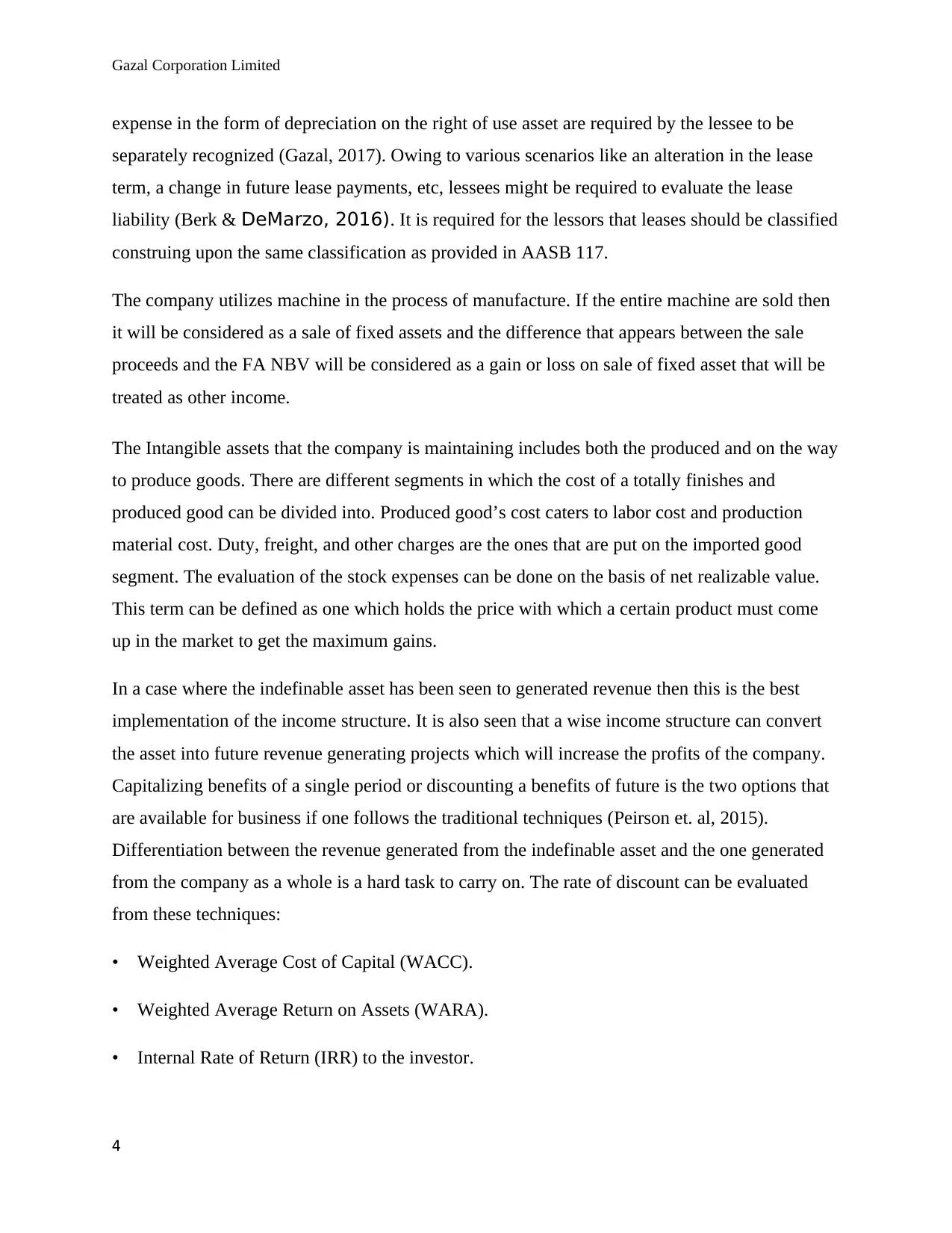
Gazal Corporation Limited
expense in the form of depreciation on the right of use asset are required by the lessee to be
separately recognized (Gazal, 2017). Owing to various scenarios like an alteration in the lease
term, a change in future lease payments, etc, lessees might be required to evaluate the lease
liability (Berk & DeMarzo, 2016). It is required for the lessors that leases should be classified
construing upon the same classification as provided in AASB 117.
The company utilizes machine in the process of manufacture. If the entire machine are sold then
it will be considered as a sale of fixed assets and the difference that appears between the sale
proceeds and the FA NBV will be considered as a gain or loss on sale of fixed asset that will be
treated as other income.
The Intangible assets that the company is maintaining includes both the produced and on the way
to produce goods. There are different segments in which the cost of a totally finishes and
produced good can be divided into. Produced good’s cost caters to labor cost and production
material cost. Duty, freight, and other charges are the ones that are put on the imported good
segment. The evaluation of the stock expenses can be done on the basis of net realizable value.
This term can be defined as one which holds the price with which a certain product must come
up in the market to get the maximum gains.
In a case where the indefinable asset has been seen to generated revenue then this is the best
implementation of the income structure. It is also seen that a wise income structure can convert
the asset into future revenue generating projects which will increase the profits of the company.
Capitalizing benefits of a single period or discounting a benefits of future is the two options that
are available for business if one follows the traditional techniques (Peirson et. al, 2015).
Differentiation between the revenue generated from the indefinable asset and the one generated
from the company as a whole is a hard task to carry on. The rate of discount can be evaluated
from these techniques:
• Weighted Average Cost of Capital (WACC).
• Weighted Average Return on Assets (WARA).
• Internal Rate of Return (IRR) to the investor.
4
expense in the form of depreciation on the right of use asset are required by the lessee to be
separately recognized (Gazal, 2017). Owing to various scenarios like an alteration in the lease
term, a change in future lease payments, etc, lessees might be required to evaluate the lease
liability (Berk & DeMarzo, 2016). It is required for the lessors that leases should be classified
construing upon the same classification as provided in AASB 117.
The company utilizes machine in the process of manufacture. If the entire machine are sold then
it will be considered as a sale of fixed assets and the difference that appears between the sale
proceeds and the FA NBV will be considered as a gain or loss on sale of fixed asset that will be
treated as other income.
The Intangible assets that the company is maintaining includes both the produced and on the way
to produce goods. There are different segments in which the cost of a totally finishes and
produced good can be divided into. Produced good’s cost caters to labor cost and production
material cost. Duty, freight, and other charges are the ones that are put on the imported good
segment. The evaluation of the stock expenses can be done on the basis of net realizable value.
This term can be defined as one which holds the price with which a certain product must come
up in the market to get the maximum gains.
In a case where the indefinable asset has been seen to generated revenue then this is the best
implementation of the income structure. It is also seen that a wise income structure can convert
the asset into future revenue generating projects which will increase the profits of the company.
Capitalizing benefits of a single period or discounting a benefits of future is the two options that
are available for business if one follows the traditional techniques (Peirson et. al, 2015).
Differentiation between the revenue generated from the indefinable asset and the one generated
from the company as a whole is a hard task to carry on. The rate of discount can be evaluated
from these techniques:
• Weighted Average Cost of Capital (WACC).
• Weighted Average Return on Assets (WARA).
• Internal Rate of Return (IRR) to the investor.
4
Secure Best Marks with AI Grader
Need help grading? Try our AI Grader for instant feedback on your assignments.
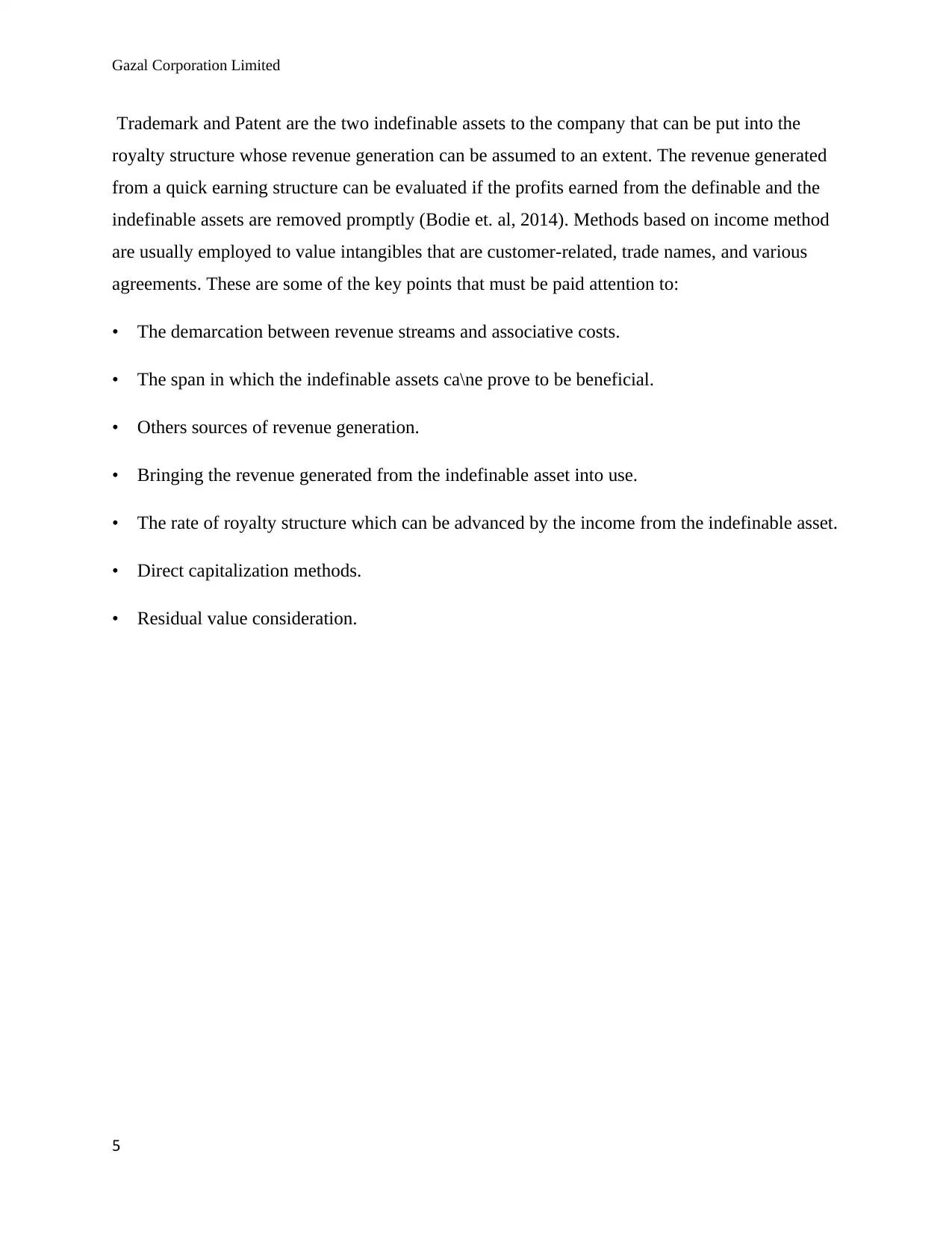
Gazal Corporation Limited
Trademark and Patent are the two indefinable assets to the company that can be put into the
royalty structure whose revenue generation can be assumed to an extent. The revenue generated
from a quick earning structure can be evaluated if the profits earned from the definable and the
indefinable assets are removed promptly (Bodie et. al, 2014). Methods based on income method
are usually employed to value intangibles that are customer-related, trade names, and various
agreements. These are some of the key points that must be paid attention to:
• The demarcation between revenue streams and associative costs.
• The span in which the indefinable assets ca\ne prove to be beneficial.
• Others sources of revenue generation.
• Bringing the revenue generated from the indefinable asset into use.
• The rate of royalty structure which can be advanced by the income from the indefinable asset.
• Direct capitalization methods.
• Residual value consideration.
5
Trademark and Patent are the two indefinable assets to the company that can be put into the
royalty structure whose revenue generation can be assumed to an extent. The revenue generated
from a quick earning structure can be evaluated if the profits earned from the definable and the
indefinable assets are removed promptly (Bodie et. al, 2014). Methods based on income method
are usually employed to value intangibles that are customer-related, trade names, and various
agreements. These are some of the key points that must be paid attention to:
• The demarcation between revenue streams and associative costs.
• The span in which the indefinable assets ca\ne prove to be beneficial.
• Others sources of revenue generation.
• Bringing the revenue generated from the indefinable asset into use.
• The rate of royalty structure which can be advanced by the income from the indefinable asset.
• Direct capitalization methods.
• Residual value consideration.
5
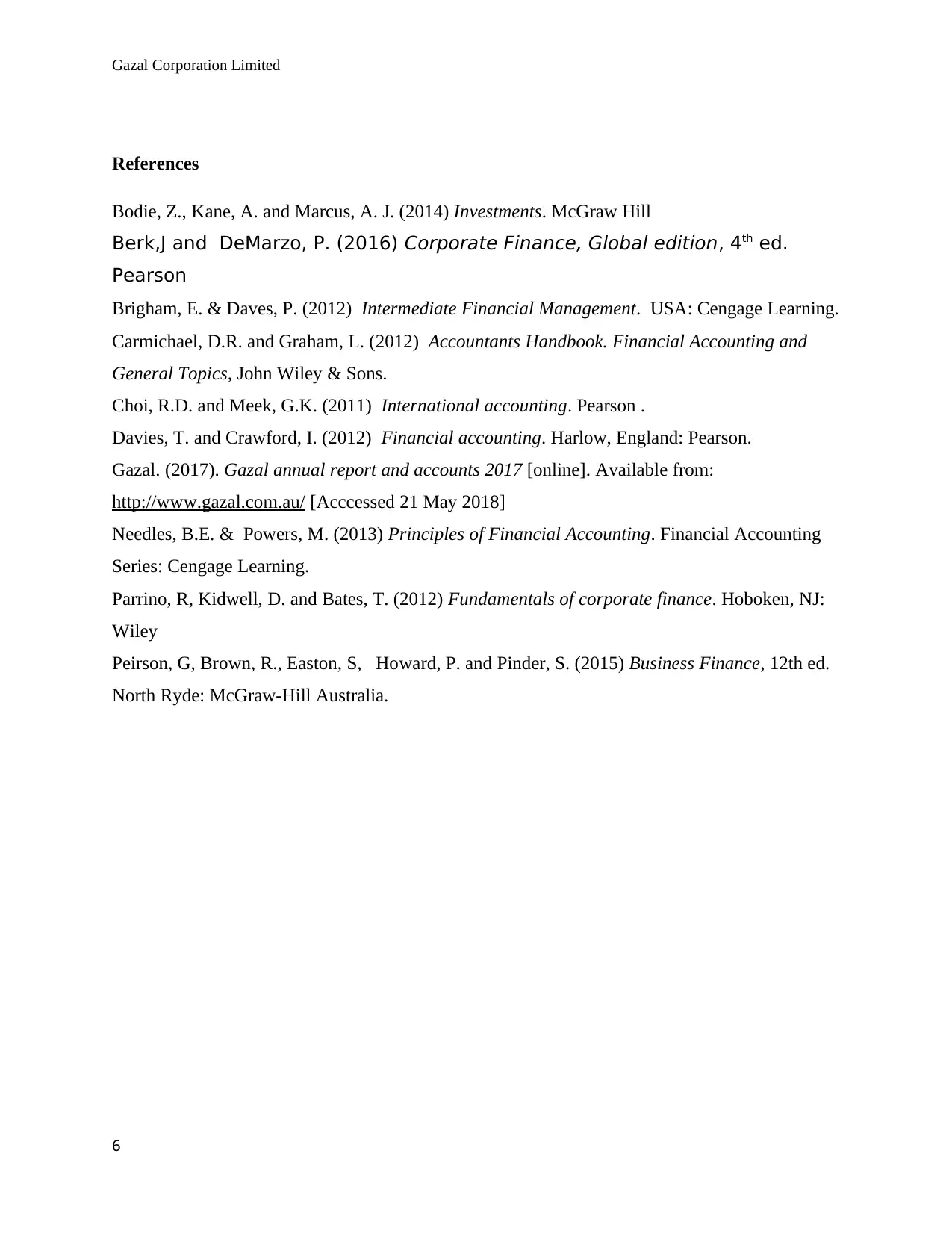
Gazal Corporation Limited
References
Bodie, Z., Kane, A. and Marcus, A. J. (2014) Investments. McGraw Hill
Berk,J and DeMarzo, P. (2016) Corporate Finance, Global edition, 4th ed.
Pearson
Brigham, E. & Daves, P. (2012) Intermediate Financial Management. USA: Cengage Learning.
Carmichael, D.R. and Graham, L. (2012) Accountants Handbook. Financial Accounting and
General Topics, John Wiley & Sons.
Choi, R.D. and Meek, G.K. (2011) International accounting. Pearson .
Davies, T. and Crawford, I. (2012) Financial accounting. Harlow, England: Pearson.
Gazal. (2017). Gazal annual report and accounts 2017 [online]. Available from:
http://www.gazal.com.au/ [Acccessed 21 May 2018]
Needles, B.E. & Powers, M. (2013) Principles of Financial Accounting. Financial Accounting
Series: Cengage Learning.
Parrino, R, Kidwell, D. and Bates, T. (2012) Fundamentals of corporate finance. Hoboken, NJ:
Wiley
Peirson, G, Brown, R., Easton, S, Howard, P. and Pinder, S. (2015) Business Finance, 12th ed.
North Ryde: McGraw-Hill Australia.
6
References
Bodie, Z., Kane, A. and Marcus, A. J. (2014) Investments. McGraw Hill
Berk,J and DeMarzo, P. (2016) Corporate Finance, Global edition, 4th ed.
Pearson
Brigham, E. & Daves, P. (2012) Intermediate Financial Management. USA: Cengage Learning.
Carmichael, D.R. and Graham, L. (2012) Accountants Handbook. Financial Accounting and
General Topics, John Wiley & Sons.
Choi, R.D. and Meek, G.K. (2011) International accounting. Pearson .
Davies, T. and Crawford, I. (2012) Financial accounting. Harlow, England: Pearson.
Gazal. (2017). Gazal annual report and accounts 2017 [online]. Available from:
http://www.gazal.com.au/ [Acccessed 21 May 2018]
Needles, B.E. & Powers, M. (2013) Principles of Financial Accounting. Financial Accounting
Series: Cengage Learning.
Parrino, R, Kidwell, D. and Bates, T. (2012) Fundamentals of corporate finance. Hoboken, NJ:
Wiley
Peirson, G, Brown, R., Easton, S, Howard, P. and Pinder, S. (2015) Business Finance, 12th ed.
North Ryde: McGraw-Hill Australia.
6
1 out of 6
Related Documents
Your All-in-One AI-Powered Toolkit for Academic Success.
+13062052269
info@desklib.com
Available 24*7 on WhatsApp / Email
![[object Object]](/_next/static/media/star-bottom.7253800d.svg)
Unlock your academic potential
© 2024 | Zucol Services PVT LTD | All rights reserved.





